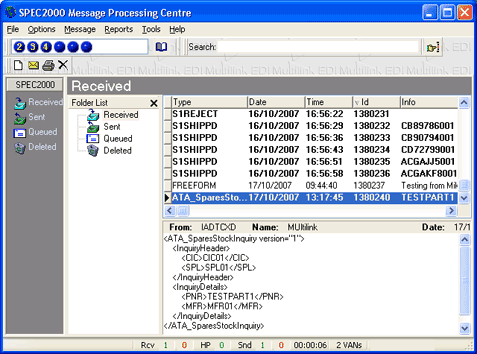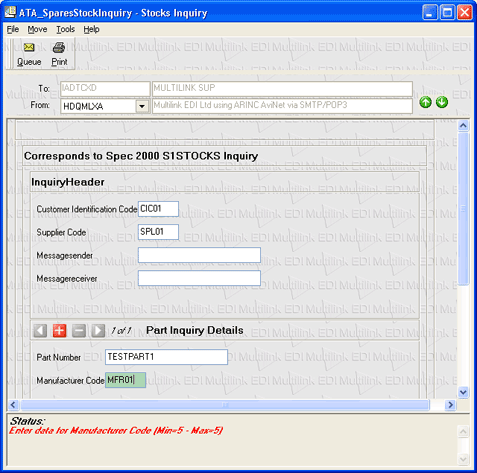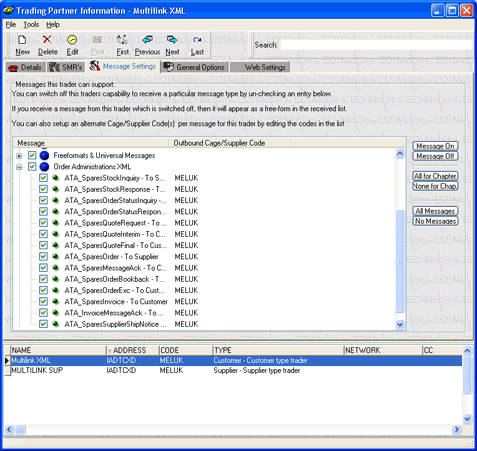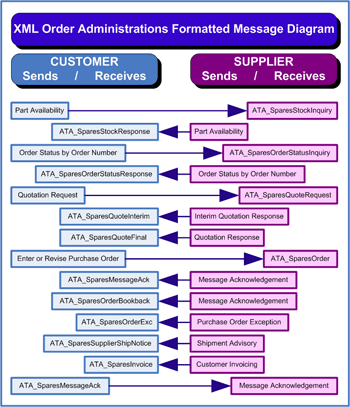Aircraft parts - quotes, orders, invoices and enquiries.
- Simplifies and standardises XML order administration transactions between suppliers and customers i.e. a single standard format
- Provides methods which can be used by the widest possible number of companies.
- Increases cash flow due to electronic invoicing.
- Improves efficiency - faster ordering process resulting in reduced inventory.
Using a standard format on the ARINC, SITA or Internet networks, orders can be placed with a supplier and, as changes like schedule dates or part numbers occur, these are transmitted from supplier to customer via order exception formats. Enquiries on order status can be made via part number or purchase order number. A shipment advisory message is sent to the customer when parts are despatched. Electronic invoices can then be sent to the customer.
- The purpose of the Order Administrations XML Module is to automate the placing or orders, order exception routines, on-line enquiries and to determine order status and automated shipment advisories plus electronic invoicing.
- The benefits of the Order Administrations XML Module are to simplify and standardise order administration.
- Receive orders in a common format to standardise administration and thus save time and money.
- Improve efficiency through faster ordering and reduced inventory.
- Increase cash flow via electronic invoicing.
Order Administrations XML module implementation overview
In line with the ATA requirement to move towards an XML standard as shown in the ATA Main document (Appendix #10, XML representations), Blue Flag Technologies has developed an integrated SPEC2000 XML Module.
The New XML Module will run seamlessly with the Standard “Type B” message modules. XML type messages and standard messages will all be processed using a single Blue Flag Technologies SPEC2000 application. “Look and feel” and processing choices are identical to existing message options.
The new Blue Flag Technologies SPEC2000 Communications Interface handles all streams of differentiated message traffic.
XML messages can be sent/received to your host system using Blue Flag Technologies SPECCOMM Plus in the usual way using Blue Flag Technologies' fully configurable and highly flexible SPECCOMM Plus Configuration application.



Text of an XML format message embedded in a standard envelope for transmission.
QK HDQMLXA
.HDQMLXA 121254
<ATA_SparesOrder version="1">
<OrderHeader>
<CIC>MELUK</CIC>
<SPL>ACEAE</SPL>
<MessageSender>BLUEFLAG</MessageSender>
<MessageReceiver>ACEAERO</MessageReceiver>
</OrderHeader>
<OrderDetails>
<TNC>
<TNC_Order>3</TNC_Order>
<TNC_Item>2</TNC_Item>
<TNC_Action>1</TNC_Action>
</TNC>
<CPO>O2342345234</CPO>
<PNR>P24W5T245T2</PNR>
<UNP ICR="USD" UNT="EA">23.12</UNP>
<QTO UNT="EA">12</QTO>
<SSD>2007-10-12</SSD>
<MFR>MAN45</MFR>
<SSM>
<ShippingMethodCode>AF</ShippingMethodCode>
<ShippingPaymentMethodCode>A</ShippingPaymentMethodCode>
</SSM>
<REM>THIS IS A TEST MESSAGE</REM>
</OrderDetails>
</ATA_SparesOrder>
Order Administrations XML Message Summary
- ATA_SparesStockInquiry - A customer can send a Part Availability message (ATA_SparesStockInquiry) to a supplier to establish stock levels. The supplier responds with a Part Availability response message (ATA_SparesStockResponse) containing stock levels, lead time and pricing information, where required.
- ATA_SparesStockResponse - A supplier can use the ATA_SparesStockResponse message to reply to a customer initiated ATA_SparesStockInquiry message.
- ATA_SparesOrderStatusInquiry - A customer can enquire about the status of an order using the Order Status Purchase Order Inquiry (ATA_SparesOrderStatusInquiry).
- ATA_SparesOrderStatusInquiryResponse - The supplier can respond to a Purchase Order Inquiry by sending a Order Status Order Number Response (ATA_SparesOrderStatusResponse). This enables the supplier to report on the stage of each item within a particular Order Number.
- ATA_SparesQuoteRequest - A customer's Quotation Request (ATA_SparesQuoteRequest) can be responded to by the supplier in two ways : either a full quotation with prices, lead times etc (ATA_SparesQuoteFinal), or Interim Response while developing a price (ATA_SparesQuoteInterim). An Interim Response (ATA_SparesQuoteInterim) can be followed by a full quotation response (ATA_SparesQuoteFinal).
- ATA_SparesQuoteInterim - A supplier can respond to a quotation request message (ATA_SparesQuoteRequest) using an interim response.
- ATA_SparesQuoteFinal - A supplier can respond to a quotation request message (ATA_SparesQuoteRequest) using a final response once all required data is available.
- ATA_SparesOrder - A customer can send the supplier a Purchase Order (ATA_SparesOrder), the arrival of which can be acknowledged by the suppiler using the ATA_SparesMessageAck message. This tells the customer that the supplier has received the order - it does NOT mean that the supplier has accepted the order or that the supplier agrees with it. If a supplier does not agree with a Purchase Order (maybe the details on the order do not match the quotation), the supplier can send a Purchase Order Exception message (ATA_SparesOrderExc) to inform the customer accordingly.
- ATA_SparesOrderBookback - A supplier can send a customer a Bookback message (ATA_SparesOrderBookback) to acknowledge receipt of a Purchase Order via an alternative delivery method (Internet, Phone, Fax etc.) , other than via SPEC2000 XML.
- ATA_SparesMessageAck - A customer or supplier is able to use the Message Acknowledgement to signify succesful reception of a particular message type that requires an acknowledgement.
- ATA_SparesOrderExc - A supplier uses the Order Exception message (ATA_SparesOrderExc) when he doesn't agree with information on a Purchase Order (ATA_SparesOrder).
- ATA_SparesSupplierShipNotice - Once a part is ready to be shipped to the customer, the supplier can send a Shipment Advisory message (ATA_SparesSupplierShipNotice). This informs the customer that the ordered parts are on the way.
- ATA_SparesInvoice - To invoice, the supplier sends a Customer Invoicing message (ATA_SparesInvoice). The combination of customer order number, part number and invoice number makes an invoice number unique - therefore there can only be one invoice per part number. When the customer receives an invoice, it can be acknowledged by a Message Acknowledgement (ATA_SparesMessageAck).
